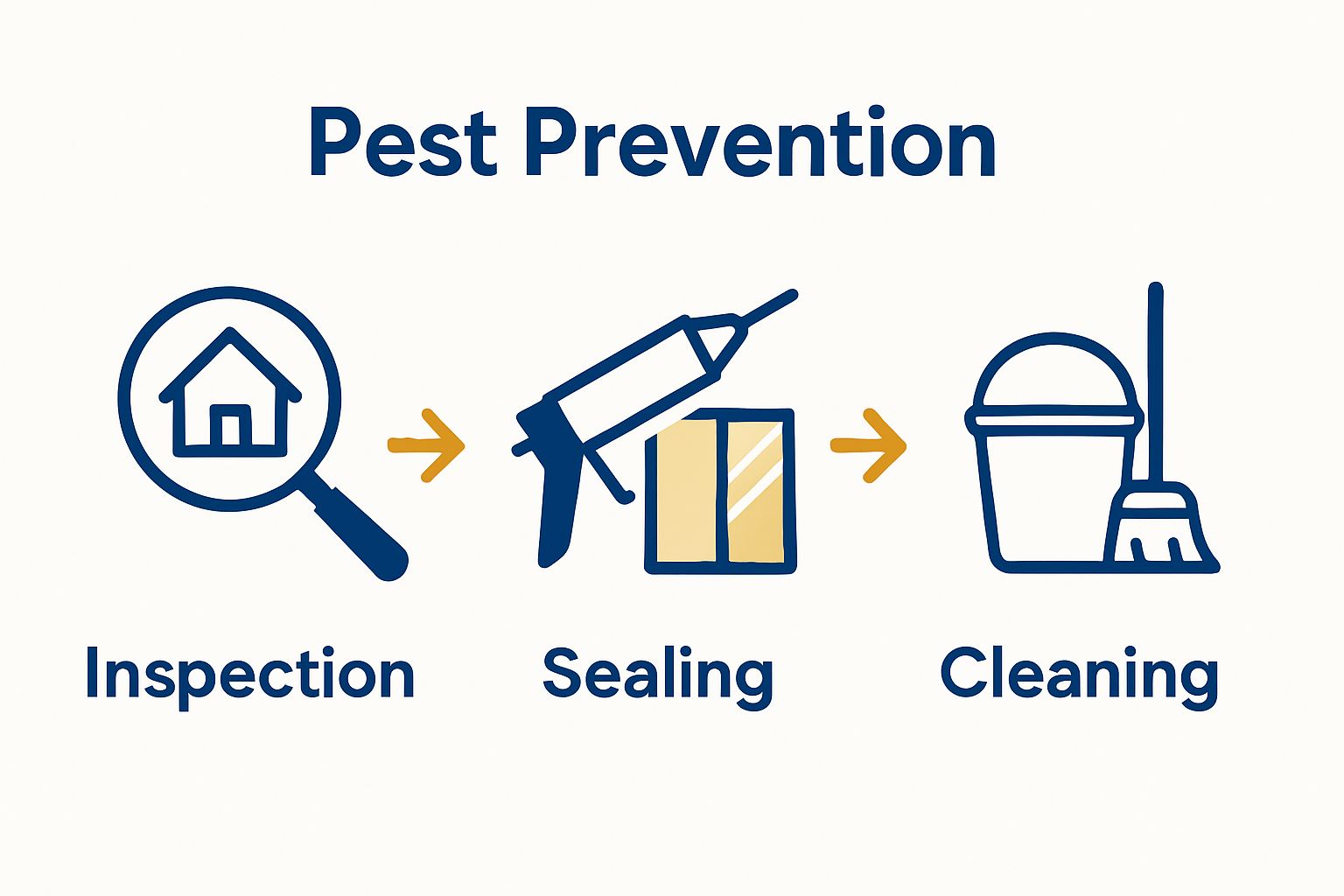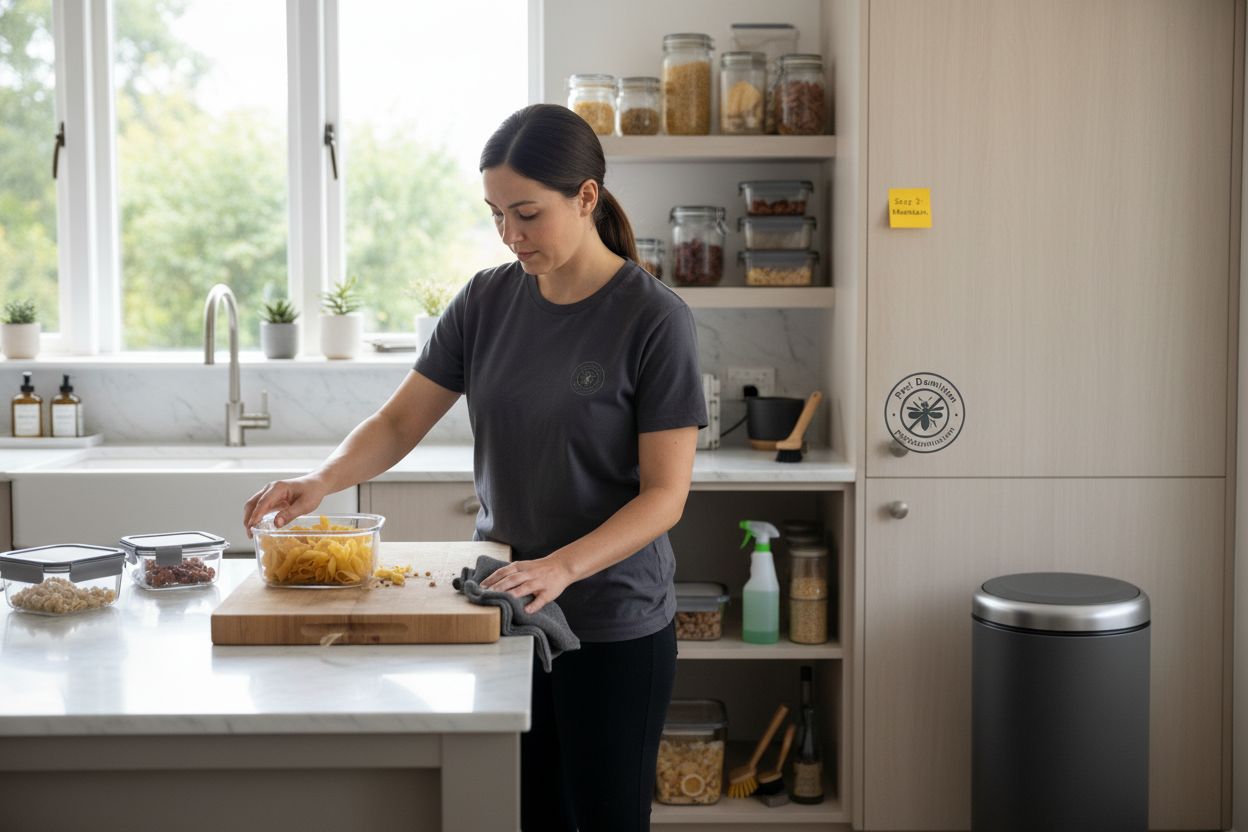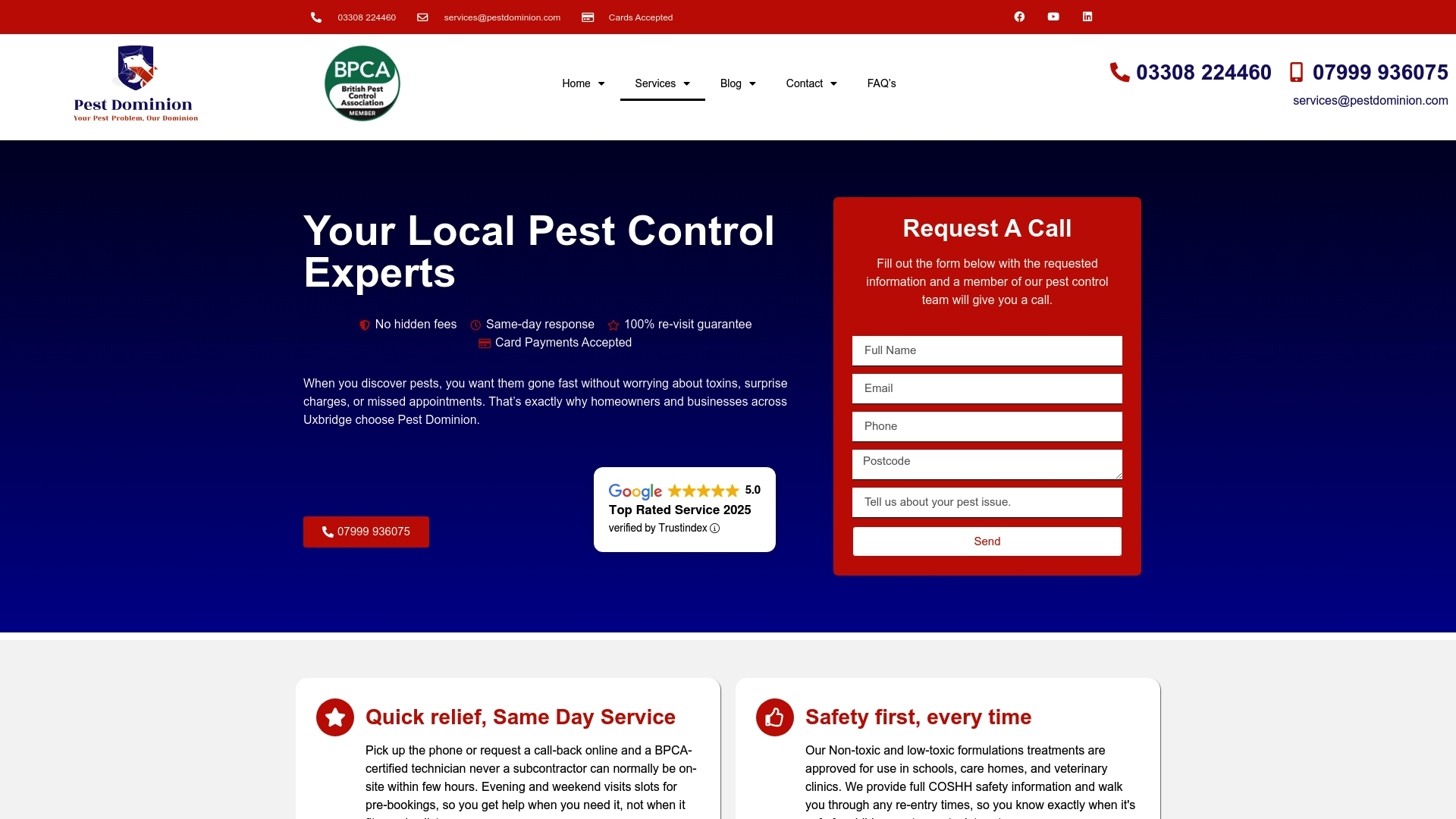Pest problems can creep into even the cleanest homes, leaving damage and frustration behind. Yet studies reveal that over 70% of infestations could have been prevented with a few simple steps. Most people obsess over expensive sprays and traps, but the real secret lies in what you do before the pests ever crawl inside.
Table of Contents
- Step 1: Assess Your Pest Problems
- Step 2: Seal Entry Points
- Step 3: Maintain Cleanliness
- Step 4: Use Natural Repellents
- Step 5: Monitor And Verify Pest Activity
Quick Summary
| Key Point | Explanation |
|---|---|
| 1. Thoroughly assess pest problems | Conduct a detailed inspection to identify potential pest entry points and evidence of infestations in your environment. |
| 2. Seal all potential entry points | Methodically close gaps and cracks outside your property to prevent pests from accessing your home. |
| 3. Maintain a clean environment | Regularly clean and declutter to eliminate food sources and hiding places, making your home less attractive to pests. |
| 4. Use natural repellents wisely | Apply essential oils and botanical barriers to deter pests without harmful chemicals, ensuring a safe home. |
| 5. Monitor pest activity consistently | Establish a routine to check for signs of pests and adjust your prevention strategies based on your findings. |
Step 1: Assess Your Pest Problems
Identifying and understanding the specific pest challenges in your environment is the critical first step in developing an effective pest prevention strategy. Before taking any action, you need a comprehensive assessment that reveals the exact nature and extent of potential pest problems.
Begin by conducting a thorough physical inspection of your property, focusing on areas most vulnerable to pest intrusion. Walk through your indoor and outdoor spaces systematically, examining potential entry points and identifying signs of pest activity. Look for telltale indicators such as droppings, gnaw marks, nests, or unusual tracks that might suggest the presence of rodents, insects, or other unwanted visitors.
Pay special attention to hidden spaces that are often overlooked: underneath sinks, behind appliances, in dark corners of basements, attics, and crawl spaces. These areas provide ideal conditions for pests to establish themselves undetected. Check wooden structures for signs of termite damage, inspect window frames and door seals for potential entry points, and examine your garden and exterior walls for nests or burrows.
For a more comprehensive assessment, our detailed pest inspection guide can help you identify specific warning signs for different types of pests. Understanding the specific challenges in your environment allows you to develop a targeted and effective prevention strategy.
Key verification indicators that you have completed this assessment successfully include:
- A documented list of potential pest entry points
- Identified specific types of pest evidence discovered
- Clear understanding of areas most at risk in your property
Remember, a meticulous assessment is your first line of defence against potential pest infestations. The more thoroughly you examine your environment, the more effectively you can prevent and address pest problems before they become significant challenges.
Step 2: Seal Entry Points
After identifying potential pest vulnerabilities during your assessment, the next crucial step is methodically sealing all possible entry points to prevent unwanted creatures from accessing your property. Effective sealing creates a robust barrier that significantly reduces pest invasion risks.
Start with a comprehensive examination of your property’s exterior, focusing on tiny gaps and cracks that might seem insignificant but can serve as highway entrances for pests. Inspect foundation walls, window frames, door thresholds, utility pipe penetrations, and roof edges. Even openings as small as a 5 pence coin can provide access for mice, while insects can squeeze through even tinier spaces.
Utilise high-quality, durable materials for sealing. Professional-grade silicone caulk works excellently for smaller gaps, while expanding foam sealants can address larger openings around pipes and structural joints. For wooden structures, use wood filler or weatherstripping to close potential entry routes. Metal mesh screens can be particularly effective for ventilation points, preventing insects and rodents from entering while maintaining airflow.
Our comprehensive pest proofing solutions guide offers additional insights into advanced sealing techniques tailored to different property types. Professional-grade materials and meticulous application are key to creating an effective pest barrier.
Critical verification indicators that demonstrate successful entry point sealing include:

- No visible gaps larger than 3 millimetres around external walls
- Proper sealing around utility entry points
- Intact window and door seals without visible deterioration
- Smooth, continuous surfaces without structural breaks
Remember that sealing entry points is not a one-time task but an ongoing process. Regularly inspect your property’s exterior, checking for new cracks or potential vulnerabilities that might develop over time. Seasonal changes and structural settling can create new opportunities for pests, so maintaining vigilance is crucial in your pest prevention strategy.
Step 3: Maintain Cleanliness
Cleanliness represents a fundamental defence mechanism against pest invasions, transforming your environment from an attractive habitat to an inhospitable zone for unwanted creatures. A meticulously maintained space significantly reduces the likelihood of pest infestations by eliminating food sources, breeding grounds, and hiding spaces that attract rodents, insects, and other unwelcome visitors.
Begin with your kitchen, the primary magnet for pest activity. Implement a rigorous cleaning protocol that goes beyond surface wiping. Immediately clean food spills, store dry goods in sealed containers, and ensure rubbish bins have tight-fitting lids. Pay special attention to areas behind appliances and underneath sinks, where food debris and moisture can accumulate unnoticed. Regularly deep clean areas like pantry shelves, refrigerator seals, and countertop crevices where crumbs and residue can attract pests.
Extend your cleaning strategy to all living spaces, including less frequented areas such as garages, basements, and storage rooms. Vacuum carpets and upholstery thoroughly, focusing on edges and corners where dust and food particles collect. Declutter storage spaces, as piles of boxes and unused items create ideal nesting environments for rodents and insects. Wash bedding, curtains, and soft furnishings regularly at high temperatures to eliminate potential pest eggs and larvae.
Our comprehensive hygiene management guide provides additional insights into maintaining a pest-resistant environment through systematic cleaning.
Key verification indicators of successful cleanliness maintenance include:
- No visible food debris or crumbs in living spaces
- Sealed food storage containers throughout the kitchen
- Regular disposal of rubbish with clean, covered bins
- Minimal clutter in storage and living areas
Remember that maintaining cleanliness is an ongoing commitment. Develop a consistent cleaning schedule, involve all household members, and treat pest prevention as a collective responsibility. Your diligence in maintaining a clean environment will create a powerful first line of defence against potential pest invasions.

Step 4: Use Natural Repellents
Natural repellents offer a safe, environmentally friendly approach to pest prevention that harnesses the power of plant-based compounds and natural ingredients to create an inhospitable environment for unwanted creatures. These chemical-free solutions provide an effective alternative to harsh synthetic pesticides, protecting your living spaces while maintaining a healthy ecosystem.
Start by exploring essential oils with proven pest-deterrent properties. Peppermint oil acts as a powerful deterrent for spiders and mice, while lavender effectively repels moths and fleas. Citrus-based oils like lemon and orange can discourage ants and other crawling insects. Create homemade repellent sprays by mixing these essential oils with water and white vinegar, applying them strategically around potential entry points and areas of pest activity. The strong aromatic compounds disrupt pest sensory systems, making your environment less attractive to them.
Expand your natural repellent strategy to include botanical barriers in your outdoor and indoor spaces. Plant pest-repelling herbs like rosemary, basil, and mint around your property perimeter. These plants not only create a natural defensive line but also add aesthetic value to your garden. Inside your home, consider placing dried lavender sachets in wardrobes, bay leaves in pantry containers, and cucumber slices near ant-prone areas. These natural solutions work by emitting scents and compounds that insects find unpleasant.
Our comprehensive natural pest management guide provides additional insights into creating effective botanical barriers.
Key verification indicators of successful natural repellent implementation include:
- Consistent reduction in pest sightings after application
- No chemical residue or harmful synthetic compounds used
- Maintained ecological balance in and around your property
- Pleasant, natural fragrances replacing chemical pest control methods
Remember that natural repellents require consistent application and rotation of strategies. Pests can develop resistance, so alternate between different essential oils and botanical approaches. Observe your environment carefully, adjusting your natural repellent techniques based on their effectiveness and the specific pest challenges you encounter.
The table below organises natural repellents and their recommended application methods, making it easy to select and use the most suitable option for your household.
| Natural Repellent | Target Pests | Application Method | Notes |
|---|---|---|---|
| Peppermint Oil | Spiders, mice | Spray around entry points, soak cotton balls | Strong aroma disrupts pest senses |
| Lavender Oil | Moths, fleas | Place sachets in wardrobes and drawers | Long-lasting fragrance, repels insects |
| Citrus Oils (lemon/orange) | Ants, crawling insects | Mix with water/vinegar and spray in kitchens | Effective near food prep areas |
| Rosemary/Basil/Mint (plants) | General insects | Plant around property perimeter | Natural barrier, adds garden appeal |
| Cucumber Slices | Ants | Place near ant-prone spots | Replace regularly for best effect |
| Bay Leaves | Pantry insects | Put in food containers and shelves | Safe for use near food |
| Dried Lavender Sachets | Clothes moths | Place in wardrobes, drawers | Chemical-free protection |
Step 5: Monitor and Verify Pest Activity
Monitoring and verifying pest activity represents the critical final stage in your comprehensive pest prevention strategy, transforming your approach from reactive to proactive. Systematic observation allows you to detect potential infestations before they become significant problems, enabling swift and targeted interventions.
Establish a consistent inspection routine that covers both interior and exterior spaces. Conduct weekly walk-throughs of your property, carefully examining areas previously identified as vulnerable during your initial assessment. Look for subtle signs of pest presence such as droppings, gnaw marks, unexplained damage, or unusual debris. Pay special attention to dark, moisture-rich environments like basements, attics, and under-sink cabinets where pests often establish hidden colonies. Use a powerful flashlight and wear protective gloves to thoroughly investigate potential hiding spots.
Consider implementing strategic monitoring tools to enhance your detection capabilities. Sticky traps placed strategically in high-risk areas can provide early warning signals of rodent or insect activity. These non-toxic devices capture evidence of pest movement without causing harm, allowing you to track patterns and identify specific entry points or breeding zones. Modern digital monitoring devices, which can detect pest movement and send smartphone alerts, offer an advanced technological approach to ongoing pest surveillance.
Our comprehensive pest control monitoring techniques guide provides additional insights into advanced tracking methods.
Key verification indicators of successful pest activity monitoring include:
- Regular documented inspection records
- No signs of active pest reproduction or expansion
- Immediate identification and response to potential pest indicators
- Maintained cleanliness and structural integrity of monitored spaces
Remember that pest monitoring is an ongoing process requiring patience and consistency. Develop a structured approach, maintain detailed records of your observations, and be prepared to adjust your prevention strategies based on emerging patterns.
Below is a summary checklist table to help you verify successful completion of each main pest prevention step. Use this as a reference for ongoing maintenance and assessment.
| Step | Verification Checklist | Evidence of Completion |
|---|---|---|
| Assess Pest Problems | List potential entry points and note pest evidence | Documented inspection notes and identified high-risk areas |
| Seal Entry Points | Ensure all exterior gaps are sealed | No visible gaps over 3mm and intact seals |
| Maintain Cleanliness | Eliminate food debris and reduce clutter | Clean living areas and sealed food storage |
| Use Natural Repellents | Regularly apply and rotate natural deterrents | Reduced pest sightings and no chemical residue |
| Monitor Pest Activity | Perform weekly inspections and record findings | Up-to-date inspection records and prompt response to indicators |
Ready for a Pest-Free Home the Natural Way?
Struggling with unwanted pests despite sealing cracks and using natural repellents? You are not alone. Many homeowners find that even meticulous inspections and regular cleaning are not always enough to halt stubborn infestations. Professional insight can make all the difference when long-term prevention and peace of mind are at stake. If you feel overwhelmed by difficult pests or want expert assurance that your property is truly protected, Pest Dominion Limited is here for you.

With our proven local expertise, we combine advanced pest prevention with safe, eco-conscious methods. From detailed property assessments to lasting pest proofing and tailored hygiene solutions, we help turn best-practice advice into real-world results. Visit Pest Dominion Limited today to secure your personalised solution. Do not wait—take control now and enjoy a healthier, safer environment for your family or business. For extra guidance or an immediate quote, you can always contact us directly.
Frequently Asked Questions
How can I assess pest problems in my property?
Begin by conducting a thorough physical inspection, focusing on areas vulnerable to pest intrusion. Look for signs such as droppings, nests, and gnaw marks, and examine hidden spaces like under sinks and in attics.
What materials should I use to seal entry points against pests?
Utilise high-quality silicone caulk for smaller gaps, expanding foam sealants for larger openings, and wood filler for wooden structures. Ensure all potential entry points are properly sealed to create an effective barrier against pests.
What natural repellents can I use to deter pests?
Essential oils like peppermint, lavender, and citrus-based oils are effective natural repellents. You can create homemade sprays using these oils mixed with water and vinegar, or use botanical barriers by planting pest-repelling herbs around your property.
How often should I monitor for pest activity?
Establish a consistent inspection routine, ideally conducting weekly walkthroughs of both indoor and outdoor spaces. Regular monitoring helps you catch potential infestations early and allows for targeted interventions.

